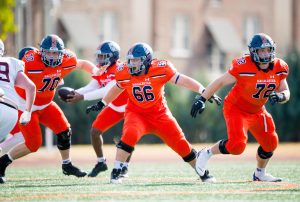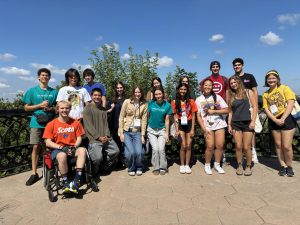Preparation for baseball season at Macalester

April 14, 2022
Baseball season has begun at Macalester. But success or failure on the baseball diamond has as much to do with what happens in the weight room in the offseason as it does with practice on the field.
“This is a special time of year,” infielder Joe Margolis ’23 said. “This is what we prepare for all off-season. All those hours working in the fieldhouse, the weight room and the training room are for this. It’s just going to be really incredible to get back out there and see what our hard work turns into.”
Throughout the year, Scott Hintz, the team’s weightlifting coach, and Karen Moberg, its head athletic trainer, work together to devise workouts that help players get stronger and more flexible and to build resistance to injury. In the off-season, the team typically works out under Hintz’s direction four-and-a-half hours a week, whereas in the regular season the workload is heavily reduced. Moberg treats injuries but also uses modes of therapy including massage to treat and prevent injury.
Senior captain William Moscato ’22 understands the impact and crucial role the training staff has on the team.
“Scott and Karen are just as important to this team as our best player or any coach,” Moscato said. “Scott understands how baseball is unique and how to design workouts to best strengthen and prepare us for the season. Karen works around the clock to be there for us and prevent injuries from sidelining us. We really owe a ton to them both.”
While Hintz and Moberg work closely together, their roles and expertise within sports science differ.
Hintz designs weight room workouts by studying and analyzing the particular demands that baseball puts on athletes’ bodies. He focuses on the legs, core and shoulders.
“Legs are important because they are the main force behind running, hitting and throwing,” Hintz said.
A strong core is essential because players are constantly rotating their torsos to swing and throw.
“[Shoulders are the] big driving forces behind throwing and swinging,” Hintz said.
Hintz also works hard to get to know the players and customize workouts to each person’s needs and challenges. Different players require unique regimens, from injury recovery to mobility to strength.
“It’s good to be with a team you have already worked with,” he said. “It allows you to know the athletes personally and know what their needs are.”
In September, the team holds practices on the field and plays off-season games against other colleges. Hintz values these off-season games.
“[The games the team plays in September are] actually helpful to our work in the weight room,” Hintz said. “It allows us to ease into things by starting with untaxing exercises.”
This is especially important for first-year athletes, many of whom have not had much experience in the weight room. Hintz takes a hands-on approach to coaching first years. He speaks with each about their prior weight room experience and studies their form, since proper form maximizes the benefits of a workout and prevents injury.
During off-season workouts, which span from October to December, Hintz focuses on helping players improve strength and mobility by gradually increasing the weight they lift and the number of repetitions they do. Hintz also often introduces new initiatives designed to maximize performance. This year, he introduced a new system called Velocity Based Training, which measures the path and speed of the barbell as players lift it to register explosivity, or the power surge that enables an athlete to perform at peak levels.
“It is not just about how much weight you move, it is also about how fast you move it [that] directly correlates to power and explosivity, which we need our players to emphasize,” he said.
Once the spring semester begins, the team begins to practice on the field again. Hintz shifts the focus of workouts to preserving gains made in the fall. In the weight room, he reduces the number of repetitions players do while maintaining the weight they lift. He also emphasizes stretching to prevent injury.
But most injury prevention and rehabilitation work is done in the training room by Moberg. According to Moberg, baseball injuries frequently result from the sport’s emphasis on high velocity overhand throwing. Because of this, she often treats arm injuries and focuses on preventative arm care by doing manual therapy. Manual therapy is physical therapy that relies on hands-on techniques such as massage.
Moberg also uses manual therapy treatments to help players get ready for both quick movements and the endurance they need to stand for hours.
“Baseball is unique because players find themselves standing around for a lot of the game,” she said. “But then, they have to react really quickly at a moment’s notice.” The methods she favors include massages, cupping and dry needling, which all draw blood flow to an injured or aggravated area of the body to speed the healing process.
Moberg believes a close relationship between the weight room and the training room is fundamental to a baseball player’s success on the field.
“It is essential for the weight room and athletic training room to work closely together,” Moberg said.











